► CAR lives with a Toyota GT86
► GT86 long-term test review
► Is it really the ultimate, affordable sports car?
In my quest to find a car as involving as my current Civic Type R long-termer, I’ve driven everything from a Porsche Cayman to Mazda MX5 RF. This week, I got behind the wheel of a Toyota GT86, a car we’ve previously had as a long-termer (you can read our report after this). Here’s what I thought of Toyota’s driver’s car.
‘Slow things down, and consider every gearchange. Once you get that dialled in, the car comes into its own – and then it’s a brilliant thing.’ That was the advice of Gareth Evans, Parker’s associate editor – and Subaru BRZ owner – after my first drive with the Toyota GT86.
I wasn’t too sure about it initially. Gearchanges felt notchy and a little less intuitive than in my Type R or the Cayman, and the bite point was rather sudden too – it’s not really a car you’ll enjoy driving around town and in traffic.
However, with Gareth’s words ringing in my ears, I fired up the GT86 again, and headed for the countryside – and it was then that the Toyota’s reputation began to make sense. With an open road ahead of you, the GT86 is one of the most exciting mainstream cars you can drive today.
It’s balanced perfectly, feels as light as its 1250kg weight suggests, and it sounds better than the current turbocharged Porsche Cayman, too. It’s not fast at all – and I’ll talk about that later, but it really doesn’t need to be.
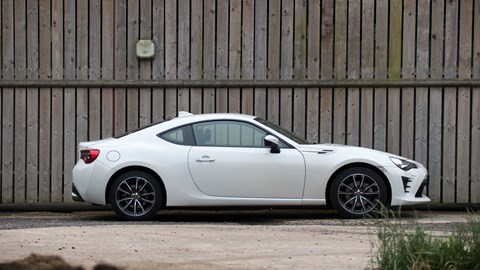
The GT86 is slower than those looks promise. But then, jumping into the Toyota after stints in the Porsche 718 Cayman and Type R, that’s kind of inevitable. Both are cars in which you can rarely put your foot to the floor. Sure, the GT86’s compact 2.0-litre flat-four delivers an amazing soundtrack, but it doesn’t propel the car forward all that fast.
So on motorways, you’ll sometimes watch other traffic stride away from you, even with your foot buried in the GT86’s carpet. Yes, throttle response is instant, there’s just not much response.
But you’re 100% having more fun than the other traffic. And this is the point of the GT86. Even on the motorway, you can nail the throttle, hear the boxer engine sing and then change up, and the whole process reconnects you to what driving’s about. And because it all happens at such a low speed, you don’t have to watch the speedometer with a degree of anxiety.
Take the GT86 on anything twister, and it really comes into its own. Find a corner, blip the throttle and then use the Toyota’s accurate, chunkily-weighted steering to pitch it in – and the GT86 feels completely predictable and balanced. And because it’s so underpowered, you can get back on the throttle almost instantly, too.
Add in skinny tyres that make the car move around just enough, and you feel like you’re really driving. Not in the assisted steering, DSC, TC, STM-enabled way, but in the old-fashioned meaning of the word.
Yes, most other cars are faster, and pretty much any car nowadays has a quicker, more responsive infotainment set-up, but that’s not really why you buy a GT86, is it?
If you enjoy driving as a pastime, and you can take the GT86 on the roads it craves, it’s easy to see why it’s held in such high regard. Despite being made in 2018, the GT86 feels classic to drive – and a world apart from most acronym-filled, tech-assisted contemporaries.
I’d still like a little more power though…
By Curtis Moldrich
Read on for our Toyota GT86 long-term test review
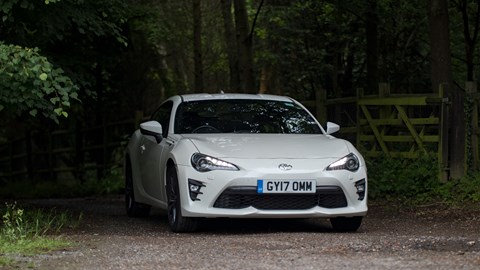
Month 8 living with a Toyota GT86: the end of CAR magazine’s long-term test review
When the Toyota GT86 arrived last spring, I wondered if the novelty of an affordable Japanese sports car would wear thin over a long-term tenure. You might guess at the demerits: the cheap interior, the below-par refinement, the fact that the 2.0-litre engine offers just 197bhp and needs to be revved to 6400rpm to muster 151lb ft. Instead, it’s reminded me that, really, I don’t care about so-so interior plastics and extra road noise when the payback is a car that feels this light and alive.
A facelift provided an excuse to get the GT86 on our test fleet. The updates included a wider-looking front bumper, new LED headlights and a much-improved – if still fairly average – 6.1-inch infotainment screen, though the nav was a £750 option.
Pricing started from £26,855, but we went for the top-spec Pro at £28,005 with heated front seats, leather and alcantara trim, leather driver’s armrest, and suede-look trim for the dash and door cards. We also added £545 to have the car painted (only red is free), and £250 for rear parking sensors. Both specs got adaptive headlights, cruise control, electric heated door mirrors and keyless entry, Bluetooth and DAB.
I deleted the new rear spoiler, and I never regretted that decision after seeing other examples. Unfortunately the same wasn’t possible with the 17-inch wheels, and I’d be highly tempted to upgrade to the default Volk TE-37s if I were keeping the keys.
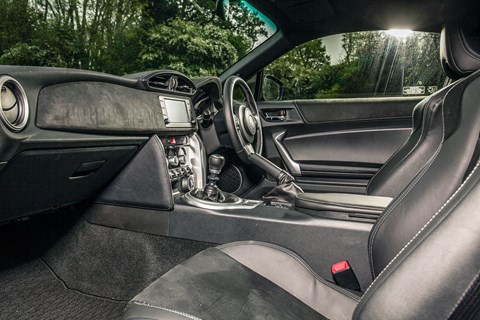
The facelift also introduced chassis tweaks, with revised springs, a thicker rear anti-roll bar and – more unusually – softer Showa shocks and a stiffer body structure.
But the new GT86 feels similar to the first prototype I drove in 2011: the roll-centre feels far lower than almost anything else you’ll drive, the front end darts about like a knee tapped with a reflex hammer, and much of the minimal weight – just 1247kg of it – feels contained between the axles, like the GT86 is pivoting around the low-slung but comfortable driver’s seat. It rides firmly, but not without compliance, so while you always feel intimately connected to the road it’s never tiresome on a longer run.
I think the GT86’s steering – with a new, smaller rim– perhaps feels even sweeter in the consistency of its weighting, speed of response and road-feel.
I’ve enjoyed driving the GT86 on the road, but I really enjoyed exploiting its nimble, adjustable balance on track when I got a few laps in with F1 driver coach Rob Wilson. I also greatly preferred the GT86 to the MX-5 I traded briefly with Mark Walton.
The naturally aspirated flat-four engine splits opinion, but its rowdy character and keen response won me over. It can be coarse, but really that’s when you hold it at around 4000rpm in readiness for an overtake. At low revs it has a deep and purposeful burble, and I like the mechanical intensity when you reach for the 7000rpm high notes.

You do need to leave your ego at the kerb sometimes, though: one of my first experiences was to spectate as a Golf R drove away from me in a straight line. And for all its reputation, this is not a car that you’ll hang at lurid angles easily – there just isn’t the power in the dry. I’ve found myself heading out specially in the wet to have fun, which has had the pleasing corollary of preserving the tyres.
All of which makes the 32.1mpg we averaged over eight months pretty staggering, just 4mpg off the official figure. Partly that’s because the GT86 spent most of its time struggling to top 70mph on the motorway, or running freely on rural A- and B-roads, but it definitely got a regular pasting. Seems the marriage of the Subaru flat-four engine – the GT86 is twinned with the Subaru BRZ, remember – and Toyota direct injection is all kinds of witchcraft.
Perhaps the biggest downside has been practicality. I regularly took my nine- and six-year old to school (one in the passenger seat, one in the back), but not once did we all go out as a family.
Sometimes, that kind of thing can make you fall out of love with a car. But with only a few days until the man from Toyota comes for the keys, all I can think of is how much I don’t want it to go back. It’s been affordable and fun, and it’s never needed a trip to the dealer. Modern hot hatches are faster, more civilized and more practical too, but for me the GT86’s balance of rawness without roughness has been pretty much perfect.
By Ben Barry
Count the cost: Toyota GT86 depreciation
Cost new £29,550 (including £1545 of options)
Dealer sale price £22,905
Private sale price £21,570
Part-exchange price £20,340
Cost per mile 15p
Cost per mile including depreciation £1.28
Logbook: Toyota GT86 Pro
Price £28,005
As tested £29,550
Engine 1998cc 16v 4-cyl, 197bhp @ 7000rpm, 151lb ft @ 6400rpm
Transmission 6-speed manual, rear-wheel drive
Performance 7.6sec 0-62mph, 140mph, 36.2mpg, 180g/km CO2
Miles this month 1097
Total 8136
Our mpg 26.9mpg
Official mpg 36.2
Fuel costs £145.52
Extra costs None
Month 7: we take our Toyota GT86 for some track-day tuition with a guru
If you watch Formula 1 on Channel 4, you might have seen Karun Chandhok’s feature on F1 driver coach Rob Wilson. Wilson is, of course, a huge talent behind the wheel – he beat Nigel Mansell in F3 – but he’s made a bigger name for himself in the passenger seat, coaching several F1 champions. But he doesn’t coach them in a racecar or even on a racetrack. He trains them on an airfield in a 1.4-litre turbo Vauxhall Astra. I took the GT86 along for an hour one evening to get some tips, after Wilson already spent a day training someone much faster.
This was actually the second time I’d been out with Wilson, having first met him for a story eight years back. So it was out in the Astra first for refamiliarisation, Wilson initially taking the wheel with his trademark casual, one-hand-on-steering-wheel chat while scorching round the cones at an almost unbelievable pace. Then it was my turn to go much slower.

The Astra is perhaps not the first car that comes to mind for this kind of work, but it felt good, with a compliant, adjustable chassis, sweet steering and an engine that’s punchy enough to be fun, if slow enough to punish mistakes that drop your momentum.
I managed to remember some of Wilson’s previous tips, especially keeping the car flat and straight whenever possible, and – part of that – making corners into V shapes, not soft Us when possible. Wilson thought I’d improved since last time, but immediately picked up on my steering. ‘What’s going on there?’ he admonished. The revelation this time was to very slightly start turning for a corner just before instinct says you should. It gives the car a little advance warning of what’s coming, and calms things down – the way you turn into a corner starts to feel more progressive, and I got a clearer sense that the tyres were going to bite earlier than I’m used to. It made me feel more confident.
Browse secondhand Toyota GT86 coupes for sale

After a few laps, I managed a 1min 50sec lap, which Wilson thought I should be pretty chuffed with. He then left me to practise in the GT86. Good as the Astra was, it’s safe to say all you future and former F1 champs would prefer the GT86. The rear-drive Toyota feels fantastic on track: low slung, agile, tightly controlled, and I particularly enjoyed being able to combine the adjustability Wilson encouraged me to exploit through tighter corners with squeezes of throttle to ride out the slides.
With modest power and weight, it was also notable how little the tyres degraded despite the coarse airfield surface. And I still seem to be getting closer to the official mpg figures at 34.7mpg!
The sports car from Japan isn’t massively quicker than the family hatch from Ellesmere Port, though – with Wilson out of the car, and hopefully me improving a little with familiarity, the GT86’s lap timer clocked 1min 48.68sec after two laps, around two seconds up on the Astra. Then again, the Toyota never has been about outright power – it’s about balance and interaction. You don’t need to be a budding F1 driver to appreciate that.
By Ben Barry
Month 6 of our Toyota GT86 long-term test review: handling and improvements to the ABS system
When the GT86 was first launched, the ABS would chime in too early. I wondered if the 17-inch tyres were to blame, perhaps because they were running out of grip before the brakes were running out of stopping power. This revised version sticks with those same Michelins, but I haven’t once triggered the ABS.
Perhaps the updated suspension does a better job of keeping the front tyres in contact with the road, perhaps the ABS is now less intrusive, but either way it feels better to me.
Browse used Toyota GT86s for sale
By Ben Barry
Logbook: Toyota GT86
Engine 1998cc 16v 4-cyl, 197bhp @ 7000rpm, 151lb ft @ 6400rpm
Gearbox 6-speed manual, rear-wheel drive
Stats 7.6sec 0-62mph, 140mph, 36.2mpg, 180g/km CO2
Price £28,005
As tested £29,550
Miles this month 444
Total 6446
Our mpg 34.9
Official mpg 36.2
Fuel £68.58
Extra costs None
Month 5 living with a Toyota GT86: the MX-5 owner takes a spin
This month, we let Mazda MX-5 driver Mark Walton loose in the GT86: here’s how he found it
The first thing I notice, climbing into the GT86, is its heft. True, the Toyota is hardly a lardball at around 1250kg, but after you’ve skipped around in a Mazda MX-5 – a featherweight at just 1070kg – anything this side of a crisp packet is going to feel plump.
The Toyota immediately feels softer and more cushioned than the Mazda. It’s also bigger – I know that sounds obvious, as the Toyota is clearly a 2+2 coupé rather than a teeny-tiny sports car, but at 6ft tall I only just fit the RF, so the Toyota’s more open cabin is a relief.
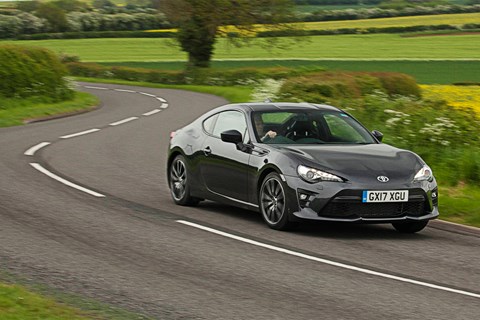
It’s like changing out of a tight suit and tie and flopping in front of the telly in a pair of baggy old Y-fronts. The Toyota may be more generous in the legroom, but of course where it falls short is the legs – its strangely weak engine. Yes, as anyone who’s read a GT86 road test over the last five years will know, the Subaru-sourced flat-four has a leaden response, a lack of midrange grunt and a strangely tinny engine note. After the fruity, fizzy MX-5, it’s a bit of a shocker.
But my first drive home is a reminder of why the GT86 is so great, despite the engine. After the edginess of the Mazda at speed – the feeling that it might just spit you off if you make a wrong move – the Toyota feels wonderfully benign. If the MX-5 is like stroking a fluffy cat that might turn and scratch you, the Toyota is a slobbery St Bernard dog that just wants to be your loyal friend. Drive the Toyota cleanly and its perfectly weighted steering is a joy, matching the MX-5 in its accuracy and feedback; but turn off the traction control and play around, and boy, it’s a wonder. Pitch it into a wet roundabout with an exaggerated steering input, stomp on the gas and it’ll start to slide, but somehow in slow motion.
It communicates its intentions with such clarity, and responds to your ham-fisted attempts to save it with such moderation, you feel you’re given extra time compared to other cars. And it’s rewarding – the more you drive it, the more you learn of the method needed to unsettle and balance it. The magic is beneath the surface, and if you live with the Toyota for a week, then you’re sworn into the GT86 fan club.

For me, the Toyota clearly wins this comparison, but I keep wondering if the soft top MX-5 would have had more of a chance. By making the RF, Mazda has plonked its two-seater sportscar right next to the GT86 and invited comparison. Dynamically the roadster is the same as the RF, but in character the soft top stands further away from the GT86, offering a more distinct flavour. If it’s a sub-£30k sports coupé you’re looking for, the GT86 is one of the best you can buy.
By Mark Walton
Logbook: Toyota GT86
Engine 1998cc 16v 4-cylinder, 197bhp @ 7000rpm, 151lb ft @ 6400rpm
Transmission 6-speed manual, rear-wheel drive
Stats 7.6sec 0-62mph, 140mph, 180g/km CO2
Price £28,005
As tested £29,550
Miles this month 1215
Total 6002
Our MPG 33.9
Official mpg 36.2
Fuel this month £194
Extra costs None
Month 4 living with a 2017 Toyota GT86: like a sporty Prius?
The GT86’s official fuel figure is 36.2mpg, and this month I averaged 32.1mpg. Pretty impressive, I’d say.
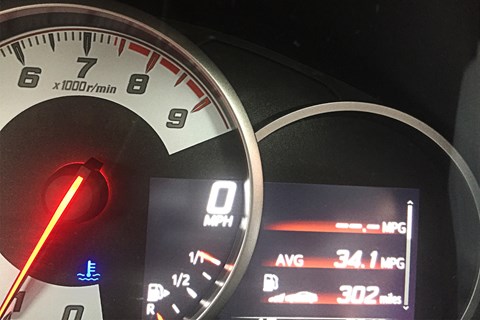
My GT86 rarely gets stuck in traffic, and mostly travels on cross-country routes or motorways. Sometimes that means simply going with the flow, but when the road’s clear it’s hard not to rinse the GT86 for everything it’s got.
Yet still it refuses to use more fuel! It almost makes me want to do an economy run to see if I can blitz those official figures. Almost.
By Ben Barry
Logbook: Toyota GT86
Engine 1998cc 16v 4-cylinder, 197bhp @ 7000rpm, 151lb ft @ 6400rpm
Transmission 6-speed manual, rear-wheel drive
Stats 7.6sec 0-62mph, 140mph, 180g/km CO2
Price £28,005
As tested £29,550
Miles this month 1250
Total 4787
Our MPG 32.1
Official mpg 36.2
Fuel this month £202.93
Extra costs None
Month 3 running a 2017 Toyota GT86: not so fast, but oh so fun
Considering its modest power output – 197bhp from the 2.0-litre flat four – the GT86 is as hard to drive slowly as the bus from Speed. In fact, everything in the little Toyota’s make up suggests you drive it as hard as you possibly can. It starts with the incredibly low-slung driving position, small-diameter steering wheel, pedals that are perfectly aligned and weighted, and the compact, friendly proportions. First impressions suggest sportiness combined with a complete lack of intimidation; rag it, definitely. Even driving the GT86 slowly, you’re unlikely to overlook the fast, sweetly weighted steering, the feeling of lightness, or the way the nose darts around so eagerly and the body remains so composed. It’d be criminal to potter about.
But perhaps unusually for a mid-lifecycle facelift, the refreshed GT86 hasn’t received any additional power. Work the revs hard and it’s perfectly fast enough, but it’s true that the naturally aspirated engine is lethargic low down – especially now all hot hatches whoosh you away from 1500rpm on a wave of turbo boost, and the Toyota manages only 151lb ft at 6400rpm. I tried to hang on to a Golf R in second gear and was quickly slapped down. You need to be getting up to 7000rpm, punching through the gear changes on the short-throw, stubby lever to get some adrenaline flowing and hear the rorty induction roar fill the cabin.
Even then, it takes pretty serious commitment to unstick the low-grip Prius tyres in the dry; I do think that’s a shame, because the GT86 feels so nicely balanced and benign when it slides, and it’d be nice to tap in to that playfulness more often. In the wet, though, it’s a hoot, giving up its grip easily if you turn off all the stability systems and sliding gracefully through corners.
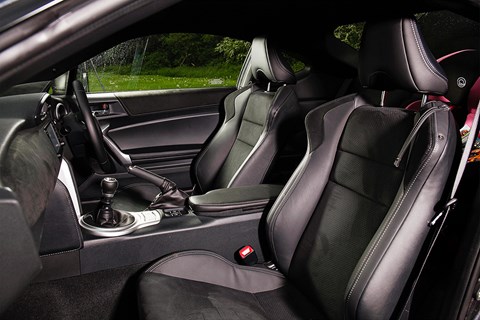
The downside to all this immediacy is a no-frills cabin, and high levels of road noise, because, well, luxuries and sound deadening add cost and weight. How many drivers recognise this as a worthwhile sacrifice? Not many, I’d wager, and that must make it quite a hard sell for Toyota. Other cars – typically those hot hatches – are faster, have a more upmarket feel and offer better refinement. But three months in, I still find myself heading out for a drive in the GT86, just for the sake of it.
By Ben Barry
Logbook: Toyota GT86
Engine 1998cc 16v 4-cylinder, 197bhp @ 7000rpm, 151lb ft @ 6400rpm
Transmission 6-speed manual, rear-wheel drive
Stats 7.6sec 0-62mph, 140mph, 180g/km CO2
Price £28,005 As tested £29,550
Miles this month 1492 Total 3537
Our MPG 33.92 Official mpg 36.2
Fuel this month £233.84 Extra costs None
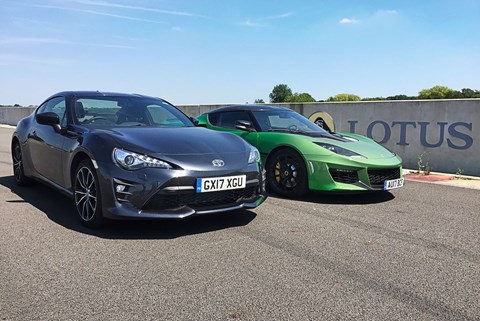
Month 2 living with a Toyota GT86: a trip to Lotus
The GT86’s first big trip involved testing the Lotus Evora Sport 410 at Hethel, appropriately enough given the Evora uses a Toyota V6 (even if the GT86 uses a Subaru flat four).
I’m embarrassed to admit that, 18 months since I last drove a GT86, I couldn’t spot the difference between the old chassis settings and the revised version’s. Still feels responsive and composed.
The steering did seem better, but perhaps that’s down to the slightly smaller steering wheel.
By Ben Barry
Month 1 running a Toyota GT86: introduction to our long-term test
It’s five years since Toyota launched the GT86, the back-to-basics sports coupe that combines low power with low weight and rear-drive intimacy. We’ve tested the production version numerous times, and ran its Subaru BRZ twin as a long-term test car; you might remember that the 2+2 sports car is a joint project between the two companies. An update for 2017 provides an excuse to get the Toyota on CAR’s fleet.
Admittedly, new GT86 looks much like old GT86 at a glance, and there are no powertrain changes: the 2.0-litre naturally aspirated engine – a Subaru flat-four with Toyota direct-injection – still produces 197bhp and 151lb ft.

But there’s a new front bumper that adds fins and continues the contour of the bonnet to a lower point than before, and new headlights that incorporate LED indicators and LED daytime running lights, and push the actual headlight unit right out to the side of the cluster – it makes the GT86’s snout appear lower, wider, a bit angrier too. There are new rear light units, a deeper rear diffuser and a new rear wing, which you can delete; I did. The body changes apparently all enhance aerodynamics. Including that, erm, deleted wing.
Inside, the steering wheel is now 3mm smaller, and 10% lighter, the 7000rpm redline now sits at the top of the tacho, Ferrari-style, and there’s a new 6.1in infotainment touchscreen to replace the frustratingly poor unit in pre-facelift cars. You also get a new 4.2in TFT multi-function display in the instrument binnacle – you can check your remaining fuel range, or watch how fast you’re burning it with the lap-timer function.
Browse Toyota GT86 for sale
Toyota says front and rear spring rates are ‘optimised’, and that they can now flex for more progressive steering feel as the body starts to roll. The Showa shocks, meanwhile, are actually softer in a bid to improve ride comfort. There’s also a thicker rear anti-roll bar, a new Track mode to minimise stability control intervention without leaving you entirely high and dry, and a revised ABS calibration. Toyota has modified the bodyshell, adding a thicker mounting bracket for the front suspension towers, a thicker reinforcement in the transmission crossmember, plus extra welds in the rear wheel arches.

The entry-level model starts from £26,855, but our car is the top-spec – and only other spec – Pro, for £28,005. The extra £1150 brings heated front seats, leather and alcantara trim (an upgrade from cloth), a leather armrest, and suede-look trim for the dash and door cards. Both specs get fresh 17in alloys, adaptive headlights, cruise control, electric heated door mirrors, keyless entry, Bluetooth and DAB.
We had to part with £750 extra for the Touch 2 with Go infotainment system, which introduces sat-nav and a few other niceties. We’ve also spent £545 on grey paint (only red is no-cost), and £250 for rear parking sensors.
That’s a final tally of £29,550. The Mazda MX-5 convertible comes closest to being a direct rival, and you can get hot hatches with more power for similar money, but five years since its launch, the GT86 continues to have the affordable rear-drive sports coupe niche to itself.
How worthwhile are the changes? What’s it like to live with? We’ve six months to find out.
By Ben Barry
Logbook: Toyota GT86
Engine 1998cc 16v 4-cyl, 197bhp @ 7000rpm, 151lb ft @ 6400rpm
Transmission 6-speed manual, rear-wheel drive
Stats 7.6sec 0-62mph, 140mph, 180g/km CO2
Price £28,005
As tested £29,550
Miles this month 605
Total 1039
Our mpg 29.8
Official mpg 36.2
Fuel this month £109.62
Extra costs None
More Toyota reviews by CAR magazine